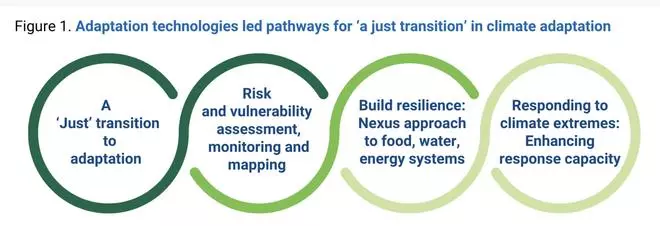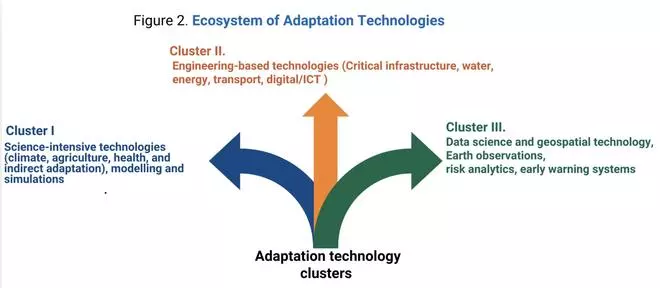An inclusive approach to climate change adaptation that emphasises a ‘just transition’ is the way forward even as the global risk emanating from warming the planet is global; adaptation is local, and resilience is specific to the people, community and ecosystem. A dedicated centre for climate change adaptation technology will promote research, knowledge generation and capacity building in India’s most vulnerable context with a focus on inclusion and climate justice.
Clear strategic focus
The National Adaptation Communication to the United Nations Framework Convention to Climate Change (2023) underscores this strategic focus, according to the Bangkok-based UN Economic Commission for Asia and the Pacific (UN-ESCAP). India’s commitment is reflected by a significant increase in adaptation finance, with total expenditure reaching 5.6 per cent of GDP in 2021-22 as against 3.7 per cent in 2015-16, it says.
Adaptation strategies demand a convergence of diverse approaches ranging from economic incentives and robust policy frameworks to locally driven interventions, says Sanjay Srivastava, Chief, Disaster Risk Reduction, UN-ESCAP. Understanding the context of risk and vulnerabilities is fundamental to any policy response, he told businessline. Monitoring and mapping are key to target vulnerable communities to embark upon ‘a just transition’ adaptation policy.
Sector-to-nexus approach
The strategy has to move from a sector to nexus approach to capitalise on inter- and cross-sectoral linkages and synergies to avoid compound and cascading impacts across sectors when disaster strikes. Adaptation technologies enable a ‘just transition’ pathway while addressing risk mapping, resilience building, and responding to climate extremes (Figure 1).

Adaptation technologies-led pathways for a ‘just transition’ in climate adaptation. | Photo Credit: UN-ESCAP
These technologies comprise three clusters: (i) science-intensive, (ii) engineering-based, and (iii) data science and risk analytics (Figure 2). Challenges lie in customisation and scaling up in the specific context of vulnerabilities. For instance, the ESCAP Risk and Resilience Portal synthesises all three clusters and offers a unique capability to visualise current and future climate scenarios at baseline, 1.5 and 2 degrees of warming, Srivastava said. This foresight is crucial for understanding the evolving risks, allowing for anticipatory actions for early warning of the changing hazard landscape.

Ecosystem of adaptation technologies | Photo Credit: UN-ESCAP
Adaptation priorities
The Mahatma Gandhi National Employment Guarantee Act, with an annual budget of $13 billion (2020), addresses locale-specific adaptation priorities. Under MNREGA, assets related to water harvesting, drought relief, flood control activities, and sanitation have been created. Satellite-derived, location-based services are being utilised for planning and monitoring nearly 7-8 million assets annually using mobile-based geo-tagging. Srivastava noted that the online geospatial maps with more than 30 million assets geo-tagged across the country have been a game changer.
Real-time monitoring
The JAM Trinity (Jan Dhan, Aadhaar, Mobile) has facilitated the transfer of over $406.9 billion to 11.67 billion beneficiaries. Real-time monitoring via geo-tagging enhances transparency and financial inclusion of poor and vulnerable through targeted policy schemes. There are more than 2,800 agri-tech startups in India driving innovation and transforming agriculture to adapt to climate risk situations. Having embraced the Internet of Things (IoT)-enabled agricultural practices to now AI-enabled machines and tech, this burgeoning ecosystem promises even more, Srivastava said.





Comments
Comments have to be in English, and in full sentences. They cannot be abusive or personal. Please abide by our community guidelines for posting your comments.
We have migrated to a new commenting platform. If you are already a registered user of TheHindu Businessline and logged in, you may continue to engage with our articles. If you do not have an account please register and login to post comments. Users can access their older comments by logging into their accounts on Vuukle.